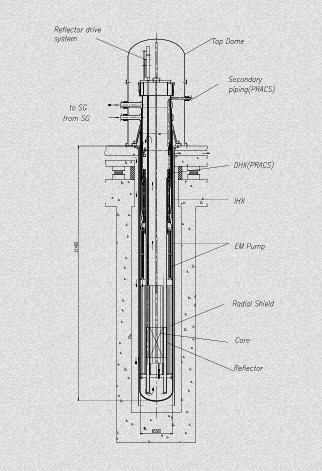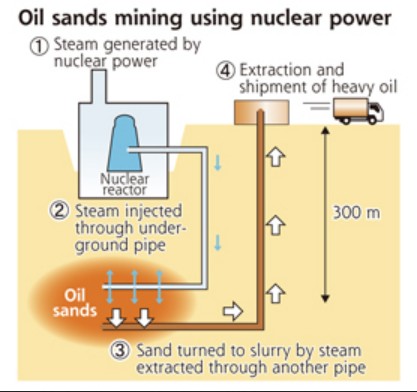Jan
17
Nuclear Reactors to Produce Oil
January 17, 2013 | 6 Comments
Al Fin found news in Japan at The Daily Yomiuri that an as yet unnamed Canadian oil sands production firm is working with the huge firm Toshiba’s nuclear reactor section to build, get approvals for and install reactors to produce steam to heat the underground oil sand’s bitumen for extraction and oil production.
The plan, as the tiny news bit allows, is for Toshiba to install a 10 MWe Model 4S nuclear reactor underground used in the situ oilsands production method. The goal is to get running by the year 2020, a mere seven years out.
What is known technically is the 4S reactor is a sodium-cooled fast neutron reactor operating at high temperature, capable of providing high temperature steam. In such a configuration working at steam assisted in situ oilsands production refueling would take place after 30 years of operation.

Toshiba Model 4S Sodium Reactor. Click image for the largest view. See the Wikipedia page for higher resolution images.
The short timeframe, by nuclear industry standards strongly suggests that Toshiba has been at work developing a small nuclear reactor for quite some time. With the tsunami induced nuclear hysteria in Japan and the nation’s export driven economy there is little surprise that the firm seems to be quite far out in front.
The news will also likely attract attention as an effort toward utilizing the nation’s nuclear technology in fields other than power generation.
On background and to refresh briefly, oil sands are sandstone deposits, which contain a viscous form of petroleum called bitumen that can be upgraded and refined for use as petroleum-based fuel. Compared with conventional oil fields, the oil sands resources have so far been difficult and expensive to develop. The current heat source for the steam production is burning natural gas.
The Daily Yomiuri said, according to its sources, the output of Toshiba’s new small reactor is reported to be in the 10,000 kilowatts to 50,000 kilowatts range, about 1 to 5 percent of a regular nuclear reactor for power generation.
Steam generated in the reactor will be sent to reservoir strata located at a depth of about 300 meters, where the oil sands are found, to turn the sand into slurry. The slurry will then be extracted from the strata using a separate pipe.
To ensure the reactor’s safety, Toshiba reportedly plans to construct a nuclear reactor building underground, while the building itself will be equipped with an earthquake-absorbing structure.
Toshiba has completed a basic design for the reactor and has already started the approval procedures for construction in the United States. The application, if in fact is progressing, has been done quietly. Meanwhile the U.S. competition must dither with politics.
Assuming Toshiba can obtain the official go-ahead from the U.S. government, Toshiba will then undergo safety checks in Canada. Then Toshiba plans to improve the level of understanding of the local folks by disclosing information about its small reactor to residents and carefully explain its safety to them.
To add to the surprise the report includes news that Toshiba has been working in Alaska and municipalities in northern Canada to introduce its small reactor as a small-scale power station. With a small size, very long fuel cycle, low cost and transportability the reactor will be quite easy to introduce in frontier areas.
Further news has it that Toshiba is considering using the reactor at desalination plants, which convert seawater into freshwater, or as a power source for electrolysis equipment to produce hydrogen for fuel battery-powered vehicles.
One can see clearly now that the U.S. nuclear industry has lost years of leadership to political infighting. Special interests may have held up U.S. technology, but on the global scale the special interest have only damaged the industry, the job market, research and development, education opportunities, business markets and investment returns.
The antinuclear crowd may have done more commercial damage than any other special interest in history in dollars, time and potential – all assisted by a nitwitted mass media and followed by cowardly and opportunist politicians.
Comments
6 Comments so far



[…] Energy and Fuel blogged about a Canadian oil sands company working with Toshiba to use their small, fast, sodium cooled 4S […]
[…] New Energy and Fuel blog speculates that the company has been at work on the reactor for a long time, given the relatively short amount of time in which it expects to have the reactor […]
[…] New Energy and Fuel blog speculates that the company has been at work on the reactor for a long time, given the relatively short amount of time in which it expects to have the reactor […]
It only makes sense to use a reactor (don’t know if Tosh’s design is appropriate) to do high-temperature hydrolysis to release high volumes of inexpensive hydrogen. The H is needed to “lighten” the bitumen. In addition to the H, nuke energy could presumably provide the heat and power necessary for a refinery. And it only makes sense to transport finished or near-finished products to market.
In terms of global CO2, this scheme greatly reduces emissions.
[…] New Energy and Fuel blog speculates that the company has been at work on the reactor for a long time, given the relatively short amount of time in which it expects to have the reactor […]
makes sense but why do it, why not just use the reactor to make liquid fuels Co2 to methanol reactions, make automotive fuel and skip the whole oil stage.